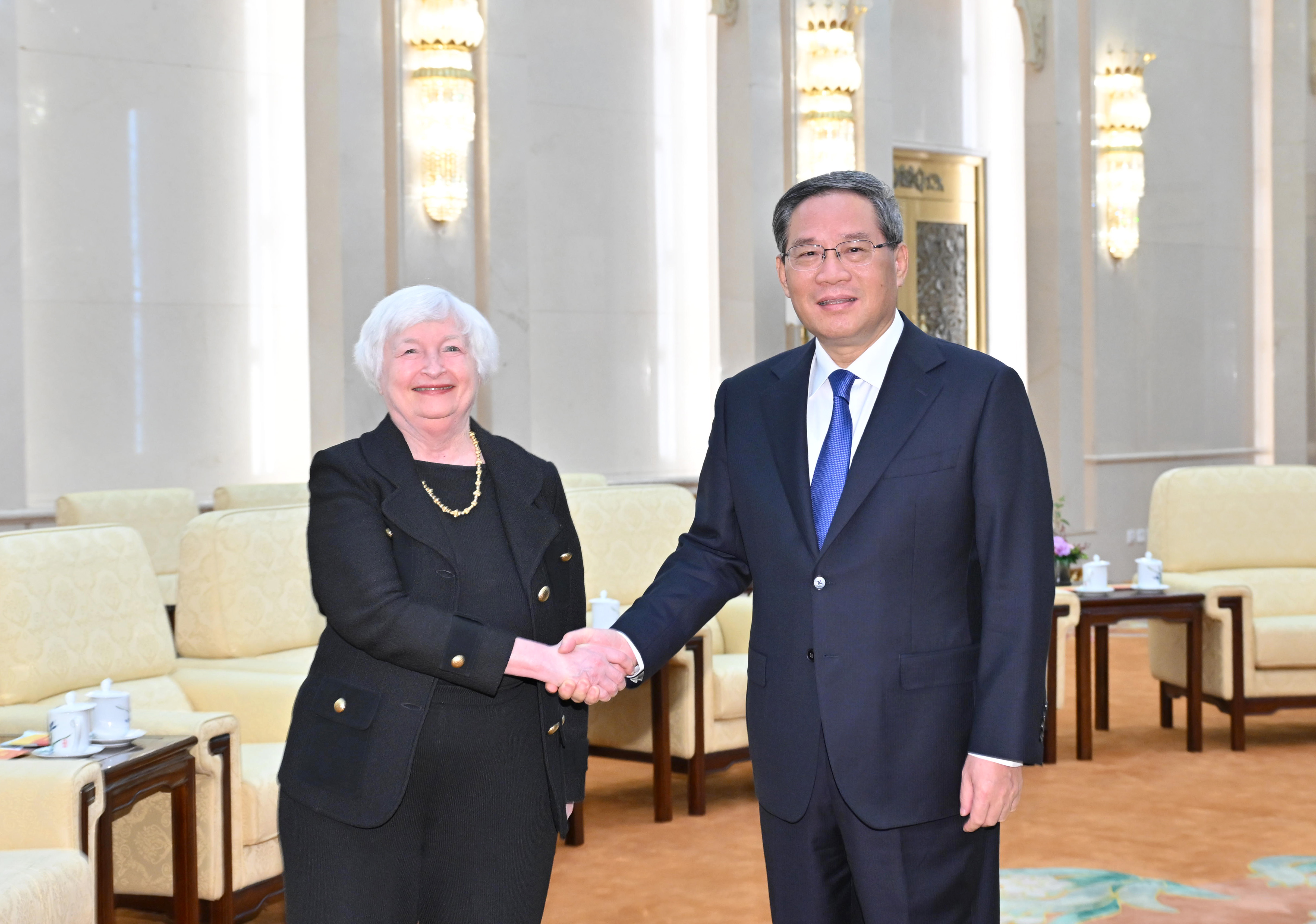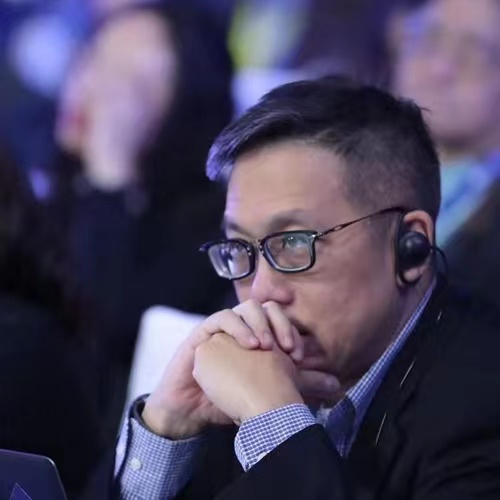By Andy Mok
Last week, US Treasury Secretary Janet Yellen touched down in Beijing. Greeted by Chinese Premier Li Qiang, he optimistically compared the tumultuous Sino-American relationship to a storm that eventually leads to a rainbow. This symbolic promise, though heartening, invites a crucial question: will Yellen's diplomatic endeavor yield a pot of gold — a symbol of prosperous collaboration — at the end of this rainbow?

Chinese Premier Li Qiang meets with US Treasury Secretary Janet Yellen at the Great Hall of the People in Beijing, capital of China, July 7, 2023. (Photo/Xinhua)
As Yellen's trip took place under the "rainbow promise," a current of skepticism persists, challenging the sincerity of her soothing remarks. Renowned American essayist Ralph Waldo Emerson's phrase, "What you do speaks so loudly that I cannot hear what you say," embodies the turbulent Sino-American relationship. Often, the U.S.'s actions have contradicted or undermined its promises, casting a shadow on its symbolic overtures.
It's essential to analyze Yellen's visit through China's lens, specifically its perception of American policy and how it could thwart China's peaceful development. Since initiating its reform era, China has remained wary of America's potential to misuse global public goods — the dollar, sea lanes of communication, and access to technology — to curtail China's growth.
Several recent events fortify these fears. The Trump administration's trade war, which saw hefty tariffs imposed on billions of dollars' worth of Chinese goods, symbolizes the weaponization of economic tools. Furthermore, the ban on Huawei, one of China's tech stalwarts, exemplifies the misuse of technology, a global public good, to suppress China's advancement in the high-tech industry. The same is true for recent restrictions on semiconductors, a critical catalyst for tech progress and innovation.
The US has not just weaponized global public goods but has also taken several confrontational actions that have strained its relationship with China, from passing controversial human rights legislation to approving significant arms sales to Taiwan. In addition, the US has openly challenged China’s sovereignty in the South China Sea through frequent naval and air patrols. With this backdrop, it's no wonder that China questions the US's trustworthiness.
However, China's stringent responses signify more than just a reactionary measure. They reflect a deep-seated and accurate assessment of the shifting power dynamics on the global stage. The contentious exchange between US National Security Advisor Jake Sullivan and Yang Jiechi, then director of the Office of the Foreign Affairs Commission of theCommunist Party of ChinaCentral Committee, at the high-stakes Alaska meeting in March 2021, illustrates this shift. It was a diplomatic clash performed on the world stage, and one that many observers saw as a watershed moment in the Sino-American relations.
The confrontation marked a departure from China's traditionally conservative stance and underscored a newfound assertiveness. The crux of this new strategic resolve lies in making America 'feel the heat' if it remains unwilling to 'see the light.' This confrontation in Alaska signals a significant turning point, as it highlights China's refusal to bow to pressure and its readiness to face off against the US on an equal footing. Hence, it is not merely about matching action with reaction; it's about upending the rules of engagement based on a clear understanding of the new global power dynamics.
China has also countered against the US’s semiconductor restrictions. A looming series of restrictions ongallium and germanium, crucial semiconductor elements, further underscores China’s intent to fight back.These elements are used in high-performance chips for applications such as artificial intelligence, 5G, electric vehicles, space technologies andradar.China is the largest producer of both elements, accounting for about 60 percent of global germanium supply and 80 percent of global gallium supply.
Starting from August 1, China will require exporters of these elements and their compounds to obtain special licenses from the state. This move could impact many US chipmakers that rely on these materials, as well as affect US military capabilities that depend on advanced radar systems.
Meanwhile, China has also targetedMicron, one of the world’s largest memory chip manufacturers, by launching a cybersecurity probe and banning it from selling to Chinese companies working on key infrastructure projects. These are separate but related actions that show China’s determination to make the US feel the heat.
However, despite rising fears of escalating provocations potentially sparking a military conflict between the US and China, it’s more likely that the US may lose its global dominance to China through a peaceful capitulation rather than a violent confrontation. That is, the US may succumb not with a bang but with a whimper.
The decisive factor could well lie within the realm of technology - whether China can create a resilient, independent semiconductor supply chain. Semiconductors are the building blocks of modern electronics, from smartphones and laptops to satellites and missiles. They are also essential for emerging technologies that will shape the future of warfare and commerce. However, China is currently dependent on foreign suppliers, mainly from the US or countries controlled by it, for advanced chips, but it has been investing heavily in developing its own capabilities and expanding its domestic production.
China has also beenforging partnerships with countries across the Middle East, Africa, Latin America and Asia. Some of these countries have been traditional US allies or partners, but have found China’s offers of trade, investment and infrastructure more attractive or pragmatic than Washington’s demands for democracy and human rights.For example, China recently brokered a deal between Iran and Saudi Arabia to restore diplomatic relations after years of hostility. This was seen as a major achievement for Beijing, as it demonstrated its ability to mediate between rival powers and promote regional stability.
Finally, China’s market is not only enormous but also increasingly open to foreign businesses and investors. China has signed free trade agreements with several countries and regions, such as the Regional Comprehensive Economic Partnership (RCEP) with 14 other Asian-Pacific nations. It has also liberalized some of its sectors, such as financial services, telecommunications and e-commerce, to attract more foreign capital and technology. China’s market size and growth potential make it an attractive destination for many companies that seek to expand their global reach and profits.
As a result, the US seems to be processing the decline of its global dominance through the lens of the five stages of grief, as proposed by Kuebler-Ross: denial, anger, bargaining, depression, and acceptance. Yellen seems to be in the bargaining phase, while key Republicans are stuck in denial or anger. A swift progression to acceptance could pave the way to global peace and prosperity.
Separately, in a bold move, Yellen attempted to distract from the root cause of the global debt crisis - the US's steep interest rate hikes - by shifting the blame onto China. Her audacious attempt to strong-arm China into shouldering the fallout of America's fiscal missteps is breathtaking. Adding to the charade is the role played by Western media, such as the New York Times. By focusing on China's internal debt issues, they conveniently obfuscate the US's culpability. This narrative casts China as the villain, obscuring the US's role in exacerbating developing nations' predicaments. A need for truthful, balanced journalism has never been more critical.
In conclusion, US Treasury Secretary Janet Yellen's recent journey to Beijing underscores a potentially transformative moment in the trajectory of US-China relations. As we stand on the precipice of a future defined by global interconnectivity, the implications of this diplomatic endeavor cannot be understated.
The metaphorical rainbow, invoked during Yellen's reception, is pregnant with symbolism, hinting at an anticipated shift from turbulent negotiations to a golden era of diplomatic discourse, mutual respect, and fruitful cooperation. Yet, as we move forward, we must do so with a healthy dose of realism.
Uncertainties remain, and the evolving global landscape continues to pose both challenges and opportunities. The rainbow, after all, could just as easily be an ephemeral mirage, a fleeting illusion of peace amidst the persisting storm of geopolitical confrontation. Nevertheless, hope persists. Our shared global future hinges on the constructive engagement of these two economic giants, making the pursuit of this 'pot of gold' an imperative endeavor.

Andy Mok is a senior research fellow of Center for China and Globalization (CCG). The article reflects the author's opinions and not necessarily the views of GDToday.
(If you want to contribute and have specific expertise, please contact us at newsguangdong@sina.com.)

















